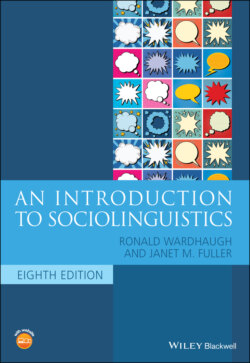Читать книгу An Introduction to Sociolinguistics - Ronald Wardhaugh, Janet M. Fuller - Страница 51
Everyone has an accent
ОглавлениеThe term dialect, particularly when it is used in reference to regional variation, should not be confused with the term accent. Standard English, for example, is spoken in a variety of accents, often with clear regional and social associations: there are accents associated with North America, Singapore, India, Liverpool (Scouse), Tyneside (Geordie), Boston, New York, and so on. However, many people who live in such places show a remarkable uniformity to one another in their grammar and vocabulary because they speak Standard English and the differences are merely those of accent, that is, how they pronounce what they say. While we will focus on variation and attitudes about English accents in this section, please keep in mind that the general points here are relevant for all languages!
One English accent has achieved a certain eminence, the accent known as Received Pronunciation (RP), the accent of perhaps as few as 3 percent of those who live in England. (The ‘received’ in Received Pronunciation is a little bit of old‐fashioned snobbery: it meant the accent allowed one to be received into the ‘better’ parts of society!) This accent is of fairly recent origin (see Mugglestone 1995), becoming established as prestigious only in the late nineteenth century and not even given its current label until the 1920s. In the United Kingdom at least, it is ‘usually associated with a higher social or educational background, with the BBC and the professions, and [is] most commonly taught to students learning English as a foreign language’ (Wakelin 1977, 5). Those who use this accent are often regarded as speaking ‘unaccented’ English because it lacks a regional association within England; we return to this point below. Other names for this accent are the Queen’s English, Oxford English, and BBC English. However, there is no unanimous agreement that the Queen does in fact use RP. Harrington et al. (2000) point out that an acoustic analysis of her Christmas broadcasts since 1952 showed a drift in her accent ‘toward one that is characteristic of speakers who are younger and/or lower in the social hierarchy.’ She ‘no longer speaks the Queen’s English of the 1950s.’ Today, too, a wide variety of accents can be found at Oxford University, and regional accents also feature prominently in the various BBC services.
The most generalized accent in North America is sometimes referred to as Newscaster English, the accent associated with announcers on the major television networks, or General American, a term which emphasizes its widespread acceptance and lack of regional association (see the website for this chapter to find a link to the discussion of Standard American English in the Do You Speak American? PBS production). Lippi‐Green (2012, 62) endorses the use of the term SAE (Standard American English), while recognizing that it is a ‘mythical’ beast and idealizes a homogeneous variety. There is no official definition of what forms are included in SAE in terms of accent or grammar; as noted by Pinker (2012), ‘The rules of standard English are not legislated by a tribunal but emerge as an implicit consensus within a virtual community of writers, readers, and editors. That consensus can change over time in a process as unplanned and uncontrollable as the vagaries of fashion.’ It is also often recognized that there are regional standards in US English; for example, while r‐lessness may be considered standard in Boston or Atlanta, it is not in Chicago; /ai/ monophthongization (e.g., the pronunciation of the vowel in the pronoun ‘I’ to sound more like ‘Ah’) is heard by newscasters in southeastern parts of the United States but not farther north or west.
Of course, there are many other varieties of English spoken around the world, in countries where English is the majority language in all or some regions (e.g., Canada, Australia, New Zealand) or in multilingual countries where it is one of several languages in widespread use (e.g., India, South Africa, Malaysia). In these contexts there are also accents which are considered standard.
As a final observation we must reiterate that it is impossible to speak English (or any other language) without an accent. There is no such thing as ‘unaccented English.’ RP is an accent, a social one rather than a regional one. However, we must note that there are different evaluations of the different accents, evaluations arising from social factors not linguistic ones. Matsuda (1991, 1361) says it is really an issue of power: ‘When … parties are in a relationship of domination and subordination we tend to say that the dominant is normal, and the subordinate is different from normal. And so it is with accent… . People in power are perceived as speaking normal, unaccented English. Any speech that is different from that constructed norm is called an accent.’ We will return to such matters in the next chapter in our discussion of language attitudes and ideologies. Further, we will address the use of English as a lingua franca (i.e., non‐native Englishes) in chapter 9.
